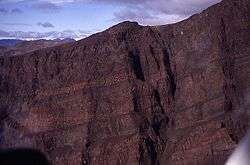Strand Fiord Formation
| Strand Fiord Formation Stratigraphic range: Late Cretaceous | |
|---|---|
 | |
| Type | Geological formation |
| Underlies | Kanguk Formation |
| Overlies | Bastion Ridge Formation |
| Lithology | |
| Primary | Sill |
| Other | Pyroclastic flow |
| Location | |
| Coordinates | 79°13′52″N 91°52′08″W / 79.231°N 91.869°W |
| Region |
|
| Country |
|
| Type section | |
| Named for | Strand Fiord |
| Named by | Souther, 1963[1] |
The Strand Fiord Formation is a Late Cretaceous volcanic component, located on northwestern and west-central Axel Heiberg Island, Nunavut, Canada. The formation contains flood basalts which are found on western Axel Heiberg Island at Dragon Cliffs 300 m (984 ft) tall.
The Strand Fiord Formation contains columnar jointing units that are usually 1 m (3 ft) to 3 m (10 ft) in diameter. The formation is interpreted to represent the cratonward extension of the Alpha Ridge, a volcanic ridge that was active during the formation of the Amerasian Basin.[2] The Strand Fiord Formation is also part of the High Arctic Large Igneous Province.
See also
- Volcanism of Canada
- Volcanism of Northern Canada
- List of volcanoes in Canada
- Ellesmere Island Volcanics
References
- ↑ Lexicon of Canadian Geological Units. Strand Fiord Formation
- ↑ Volcanic style in the Strand Fiord Formation (Upper Cretaceous), Axel Heiberg Island, Canadian Arctic Archipelago Retrieved on 2007-08-15
This article is issued from
Wikipedia.
The text is licensed under Creative Commons - Attribution - Sharealike.
Additional terms may apply for the media files.